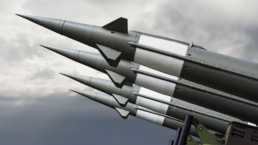Climate change is not the only man-made threat that could wipe out humanity; a nuclear war would also do that.
By Matthew Rozsa, Salon
Suddenly, the threat of nuclear war feels closer than it has in decades. The Bulletin of Atomic Scientists updated their Doomsday Clock to 100 seconds to midnight, and President Joe Biden has issued increasingly ominous statements reflecting how the looming conflict over the Ukraine that could ensnare both Russia and the west into conventional war.
And, some fear, war with nuclear weapons. It is a prospect that has haunted human beings since the dawn of the Cold War. Politicians who were perceived as too open to the idea of nuclear war would pay for their hawkishness at the polls. Motion pictures from “Dr. Strangelove” to “The Day After” have depicted an uninhabitable world, filled with lethal amounts of radiation and short on necessities like food and water. As our electrical infrastructure collapsed around us, people would resort to looting and other violent methods to survive. The seeming deterioration of civilization during the early months of the COVID-19 pandemic would be nothing compared to the anarchy and destruction that would follow nuclear war.

Yet decades of living with nuclear weapons have produced a broad body of knowledge as to what a nuclear war might do to the planet, and to humanity. If even a “small” nuclear war were to break out, tens of millions of people would die after the initial blasts. A blanket of soot would wrap the rays of the Sun and cause a nuclear winter, destroying crops all over the planet and plunging billions into famine. In the northern hemisphere, there would be such severe ozone depletion from the nuclear smoke that organisms would suffer from increased exposure to damaging ultraviolet light. While things would not be as bad in the southern hemisphere, even well-positioned countries like Australia would face the ripple effects from a small nuclear war in the northern hemisphere by sheer virtue of its interconnectedness with the global community.
Recent Posts
‘Unconstitutional. Unethical. Authoritarian.’ ICE Bars Millions Of Immigrants From Bond Hearings
July 18, 2025
Take Action Now One watchdog said the new policy “seems like a blatant attempt to stop them from exercising their right to due process.”……
Americans Are Not Nearly Alarmed Enough About Climate Change
July 18, 2025
Take Action Now Americans still don’t comprehend how imminent, dangerous, and far-reaching the threat is—and journalists are partly to blame.By…
The IRS Is Building A Vast System To Share Millions Of Taxpayers’ Data With ICE
July 17, 2025
Take Action Now ProPublica has obtained the blueprint for the Trump administration’s unprecedented plan to turn over IRS records to Homeland Security…
Israel’s Sudden Assault On Syria Is Unchecked Aggression
July 17, 2025
Take Action Now Jerusalem is bombing Damascus and threatening al-Sharaa’s rule, while Washington was hoping to help the nascent government on…




